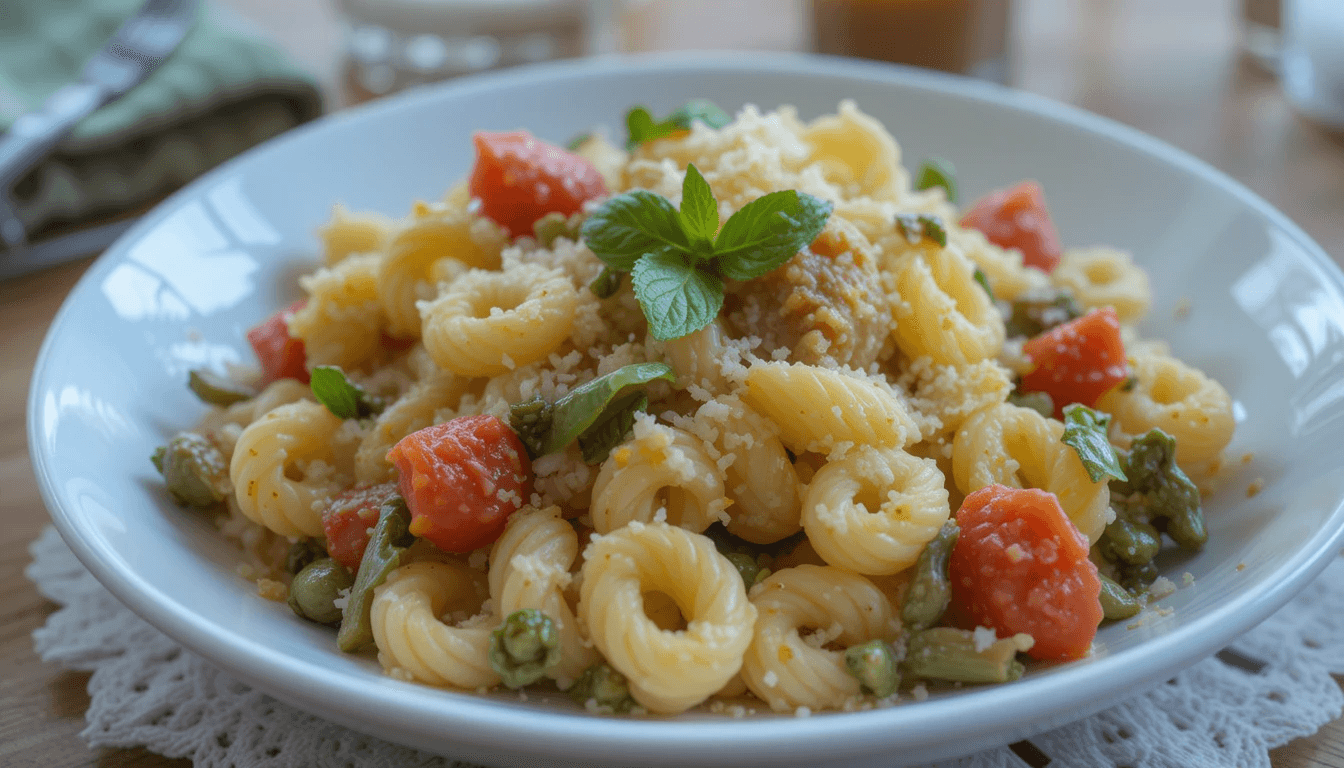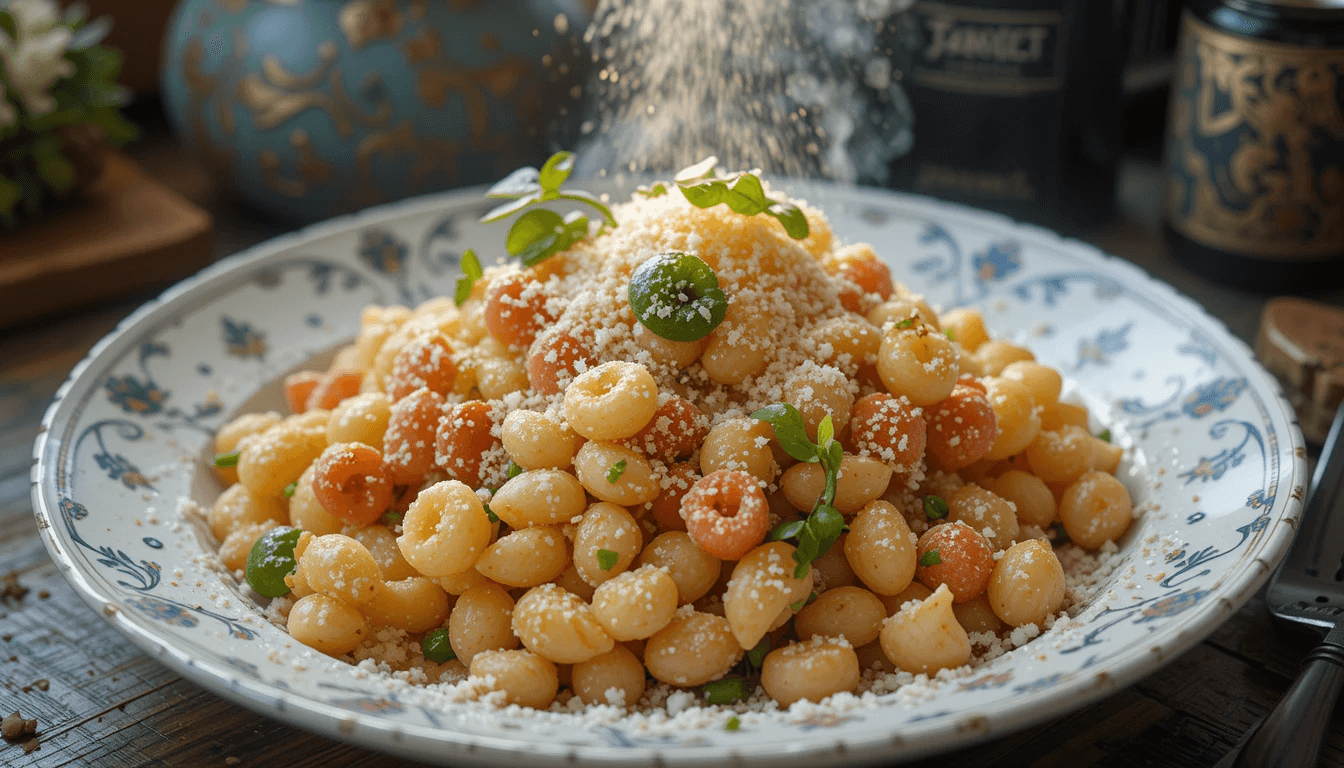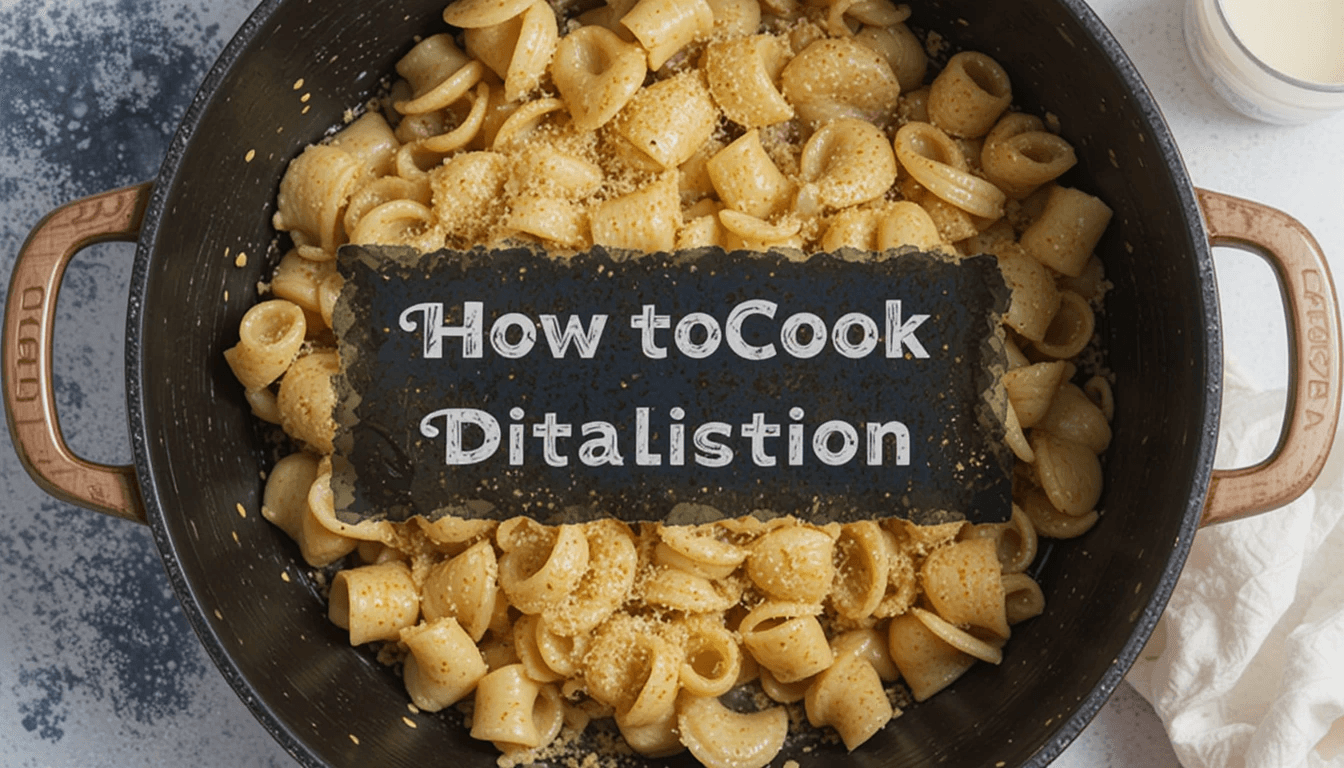
A ditalini pasta recipe is a simple yet satisfying dish featuring small, tube-shaped noodles that work in everything from creamy soups to hearty casseroles.
In this article, you’ll learn exactly how to cook, flavor, and elevate this comforting pasta staple. Whether you’re a total beginner or a seasoned home cook, this ditalini pasta recipe guide has all the insider tips you need.
Does the thought of a warm, cozy bowl of pasta instantly bring a smile to your face? You’re not alone. There’s something magical about the small, stubby shape of ditalini pasta that soaks up sauces like a sponge, transforming every bite into a burst of flavor.
Here’s where the ditalini pasta recipe truly shines—it’s delicious, hearty, and immensely versatile. Whether you’ve known this pasta since childhood or stumbled upon it for the first time, you’ll soon discover that ditalini isn’t just a filler; it’s a canvas for culinary creativity.
Disclaimer: This article is for informational purposes only and does not replace professional veterinary advice. Always consider individual dietary needs and consult a registered dietitian or medical professional if you have any health concerns about your meal choices.

The Charm of Ditalini Pasta
Before diving deeper into the world of ditalini pasta recipe magic, let’s talk about what makes these little tubes so special. Often described as “little thimbles,” ditalini boasts a ridged or smooth exterior (depending on the brand) that’s tailor-made for capturing savory sauces or hearty broths. Their petite size means they cook quickly, making them an ideal choice for busy weeknights.
Why go for a ditalini pasta recipe over other short pasta shapes? It’s all in the details. Ditalini is compact enough to fit neatly on a spoon, so it’s often the preferred choice for soups like minestrone. It also forms the perfect bite-sized companion to beans, meat, or veggies in a variety of dishes. According to a 2020 survey by the National Pasta Association Source:[NationalPastaAssociation](https://ilovepasta.org)Source: [National Pasta Association](https://ilovepasta.org), smaller pasta shapes, including ditalini, have steadily grown in popularity because they’re easy to cook and portion, making them a family favorite for quick meals.
When you cook a ditalini pasta recipe, you’re also plugging into a rich culinary heritage. Ditalini, often associated with the cuisine of Southern Italy, has historically been used in hearty home-style soups. Over time, as more pasta-lovers discovered how versatile ditalini could be, it made its way into salads, casseroles, and even some unexpectedly sweet dishes. That’s the kind of reach this small pasta shape has—it can comfortably inhabit countless flavor profiles.
Key Ingredients for a Tasty Ditalini Pasta Recipe
When it comes to building a foolproof ditalini pasta recipe, you’ll want to keep a few essential ingredients on hand. Here’s a basic rundown:
- Ditalini Pasta
- The star of your ditalini pasta recipe, obviously! Opt for high-quality, durum wheat semolina pasta. A good brand will ensure better texture and flavor.
- Sauce Base or Broth
- Tomato-based sauces, cream sauces, or even a simple broth can form the foundation of your ditalini pasta recipe.
- Consider using low-sodium broth if you’re watching your salt intake.
- Aromatic Vegetables
- Onion, garlic, carrots, or celery add depth to any ditalini pasta recipe.
- Chop them finely so they blend seamlessly with the small pasta shape.
- Proteins (Optional)
- Ground beef, shredded chicken, beans, or tofu can turn your ditalini pasta recipe into a more filling meal.
- Choose lean cuts or plant-based options if you want a healthier twist.
- Herbs & Spices
- Basil, oregano, rosemary, thyme—any of these can add a layer of aromatic complexity to your ditalini pasta recipe.
- Season with salt and pepper to taste, and don’t forget a splash of olive oil for extra richness.
- Cheese & Garnishes
- Parmesan, mozzarella, or pecorino can top off your ditalini pasta recipe with a creamy finish.
- Fresh herbs like parsley or basil can add a pop of color and freshness.
Remember, a ditalini pasta recipe can be as simple or as extravagant as you want. Sometimes, all you need is a quality tomato sauce, a sprinkle of cheese, and a dash of seasoning. Other times, you may want a more elaborate dish with multiple layers of flavor. The beauty lies in its flexibility.

How to Cook Ditalini to Perfection
1. Boiling the Pasta
- Start with Ample Water: A big pot of water helps keep the pasta from sticking. Aim for about 4 quarts of water per pound of ditalini.
- Add Salt: Salt your water generously—this is your first layer of seasoning for any ditalini pasta recipe. A general guideline is 1–2 tablespoons of salt per 4 quarts of water.
- Cook to Al Dente: Ditalini typically takes around 8–10 minutes to reach al dente. Be sure to taste a piece before draining. For soups, you might slightly undercook them since they’ll soften more in the broth.
2. Draining & Rinsing
- Drain Thoroughly: Shake off the excess water in a colander to prevent soggy pasta.
- Don’t Rinse (Unless for Salad): For a warm ditalini pasta recipe, rinsing washes away valuable starches that help sauces cling to the pasta. However, if you’re making a cold pasta salad, a quick rinse in cold water can stop the cooking process and keep them from clumping.
3. Sauce Integration
- Combine Immediately: If your ditalini pasta recipe calls for a specific sauce, toss the pasta in right after draining to absorb maximum flavor.
- Reserve Pasta Water: Save about ½ cup of the starchy cooking water to help bind your sauce to the pasta, especially in tomato-based or cream-based recipes.
Cooking your ditalini properly is the foundation of any successful ditalini pasta recipe. Undercooking leaves it hard in the middle, while overcooking can result in a mushy texture. Aim for a pleasant bite, often referred to as “al dente,” which translates to “to the tooth” in Italian. That’s where the texture of these little tubes truly shines.
A Classic Ditalini Pasta Recipe (Step-by-Step)
Now that you know the basics, here’s a classic ditalini pasta recipe to get you started. This recipe combines a tomato-forward sauce with aromatic vegetables and a touch of cheese. Feel free to adapt it with extra veggies or proteins.
Ingredients (Serves 4–6)
- 1 pound ditalini pasta
- 2 tablespoons olive oil
- 1 small onion, finely chopped
- 2 cloves garlic, minced
- 1 can (28 oz) crushed tomatoes (low-sodium if possible)
- 1 teaspoon dried basil
- ½ teaspoon dried oregano
- Salt and pepper to taste
- ¼ cup grated Parmesan cheese
- Optional: ½ cup cooked ground beef or sausage
Instructions
- Boil the Pasta
- Bring a large pot of salted water to a rolling boil. Cook the pasta for about 8–9 minutes, or until al dente. Once done, drain the pasta, reserving ½ cup of the cooking water for later.
- Sauté Aromatics
- In a separate pan, heat olive oil over medium heat. Add chopped onion, cooking until translucent (about 5 minutes). Stir in the garlic and sauté for another minute.
- Add Tomatoes & Seasonings
- Pour in the crushed tomatoes, basil, oregano, salt, and pepper. Stir well and let the sauce simmer for 10–15 minutes. If you want to include ground beef or sausage, stir it in at this stage.
- Toss the Pasta
- Add the cooked ditalini to the sauce. Mix thoroughly to coat every tube in the rich tomato sauce. If the mixture seems too thick, drizzle in a bit of the reserved pasta water.
- Top with Cheese
- Turn off the heat and sprinkle the Parmesan cheese on top. For a more robust cheesy flavor, you can also stir in some mozzarella or pecorino. Serve hot.
This classic ditalini pasta recipe delivers a comforting bowl of hearty, tomato-infused pasta that’s ideal for any night of the week. You can pair it with a simple green salad, crusty bread, or garlic knots for a more substantial meal. If you’re looking for variety, throw in some chopped spinach or zucchini. The possibilities are truly endless.
Variations to Explore
One of the biggest draws of a ditalini pasta recipe is its adaptability. Here are some fun and easy variations to keep things fresh in your kitchen:
- Minestrone-Style Soup
- Add cooked ditalini to a vegetable or chicken broth loaded with carrots, celery, beans, and tomatoes. Let it simmer for a few minutes to meld flavors.
- Creamy Alfredo Ditalini
- Combine your ditalini with a homemade Alfredo sauce or a store-bought favorite. Top it off with grilled chicken or sautéed mushrooms for added protein.
- Cheesy Baked Casserole
- Mix ditalini, ricotta cheese, and spinach in a baking dish. Cover with mozzarella and bake until golden and bubbly.
- Pasta Salad Delight
- Rinse your ditalini in cold water. Toss with olive oil, fresh veggies, cubed cheese, and your favorite vinaigrette.
- Southwestern Twist
- Stir in black beans, corn, diced tomatoes, and a dash of chili powder or cumin. Top it with shredded cheddar for a Tex-Mex style ditalini pasta recipe.
No matter the variation, the essence of a ditalini pasta recipe remains the same: small tubes that promise big taste. If you love experimenting, try mixing and matching different sauces, proteins, and vegetables to discover your personal favorite.
Healthy Substitutions
While a ditalini pasta recipe can be indulgent, there are ways to make it lighter and more nutritious:
- Whole Wheat or Gluten-Free Ditalini
- Many brands now offer ditalini made from whole wheat, chickpeas, or other gluten-free grains. This can boost the fiber content and make the dish more diet-friendly.
- Low-Sodium Sauces
- If you’re watching your salt intake, choose reduced-sodium tomatoes or broths. You can also limit added salt and rely on herbs and spices for flavor.
- Load Up on Veggies
- Toss in bell peppers, zucchini, spinach, or mushrooms to give your ditalini pasta recipe a healthy twist. Vegetables add vitamins, minerals, and fiber without piling on calories.
- Lean Proteins
- Swap out fattier meats for lean chicken, turkey, or plant-based proteins like beans, lentils, or tofu. You’ll still get ample protein without excessive saturated fat.
- Less Cheese, More Herbs
- While cheese is undeniably delicious, go lighter on it if you’re cutting back on fat. Fresh herbs like parsley, basil, or cilantro can still add tons of flavor.
By incorporating these suggestions, you can transform any ditalini pasta recipe into a balanced meal that fits your lifestyle. Remember, healthy eating is all about making small, sustainable changes that resonate with your taste buds and nutritional needs.
Expert Tips for Elevating Your Ditalini Pasta Recipe
Even though a ditalini pasta recipe is straightforward, a few expert techniques can take your dish from ordinary to extraordinary:
- Toast the Pasta
- Lightly pan-toast dry ditalini in olive oil before boiling. It might sound unconventional, but this can give the pasta a slightly nutty, deeper flavor. Just be careful not to burn it.
- Use Quality Ingredients
- Choose high-grade pasta, fresh vegetables, and artisan cheese whenever possible. The simpler the recipe, the more each ingredient matters.
- Layer Your Flavors
- Sauté your onions and garlic first. Then add in herbs, letting them bloom in the oil. Finally, incorporate sauces or broth for a well-rounded flavor base.
- Don’t Forget Texture
- Top your ditalini pasta recipe with toasted breadcrumbs or crushed nuts for extra crunch. Textural variety keeps each bite interesting.
- Finish With Fresh Herbs
- Stir in basil, parsley, or chives at the end to maintain their bright color and fresh taste. Cooking them for too long can dull their flavor.
Renowned Italian chefs often highlight the importance of simple, high-quality components in any pasta dish. According to a 2019 study in the Journal of Culinary Science & Technology, using fresh herbs and quality oils can enhance both the taste and the nutritional profile of your meal. Keep these principles in mind when crafting your ditalini pasta recipe.
Cooking for Special Occasions
A ditalini pasta recipe may be your go-to for everyday meals, but it can also shine on special occasions. Whether you’re hosting a holiday dinner or a birthday party, ditalini can be dressed up to impress:
- Festive Buffet Dish
- Create a large batch of baked ditalini casserole, layering in vegetables and cheese. It travels well and stays warm for an extended period, making it perfect for potlucks.
- Family Gatherings
- Whip up a classic Italian soup with ditalini, beans, and veggies. Pair it with crusty bread, and you have a hearty starter that’s sure to be a hit.
- Dinner for Two
- Impress your date by preparing a creamy lobster or shrimp ditalini. Top it with finely chopped chives and a sprinkle of freshly grated Parmesan.
- Vegetarian Spread
- Combine ditalini with roasted vegetables, a drizzle of high-quality olive oil, and a dusting of smoked paprika. Garnish with toasted pine nuts for an elegant, meat-free dish.
With a bit of creativity, a ditalini pasta recipe can stand proudly on your holiday table alongside roasts, appetizers, and desserts. Its small shape is easy to serve, and the wide range of flavor possibilities means it can match nearly any theme or season.
Storing and Reheating Leftovers
One of the best things about a ditalini pasta recipe is how well it lends itself to meal prepping. If you’ve made a big batch, you can easily store and reheat portions for busy weekdays:
- Refrigerate Properly
- Allow your dish to cool to room temperature before sealing it in an airtight container. Store it in the fridge for up to 3–4 days.
- Reheat Gently
- If it’s a saucy ditalini pasta recipe, reheat on the stovetop with a splash of water or broth to loosen it up. For baked casseroles, pop them in the oven at 350°F (175°C) for about 15–20 minutes until warmed through.
- Freezing Tips
- You can freeze many ditalini dishes for up to 3 months, especially soups. However, if the recipe includes dairy-based sauces, they may separate upon thawing. It’s best to freeze the sauce separately and cook fresh ditalini when you’re ready to eat.
By following these steps, you can savor your ditalini pasta recipe throughout the week without compromising its taste or texture. Proper storage also helps maintain food safety and reduce waste—a win-win for both you and the environment.
FAQs
1) What is the difference between ditalini and ditali pasta?
Ditalini is typically smaller and often used in soup-based ditalini pasta recipe ideas. Ditali is slightly larger but can serve a similar function in meals. Both make excellent bases for a hearty ditalini pasta recipe.
2) Why use ditalini pasta?
Its small tubes are perfect for soaking up sauces and flavors, making any ditalini pasta recipe more delicious. It also cooks quickly and pairs well with soups or casseroles. These reasons make it a top pick for your next ditalini pasta recipe.
3) How long does it take to boil ditalini?
Ditalini usually takes about 8 to 10 minutes to cook in a ditalini pasta recipe. Aim for al dente for a pleasant bite. Always taste-test a piece to ensure perfect texture for your ditalini pasta recipe.
4) What does it mean when a recipe calls for dried pasta?
It indicates uncooked pasta made from semolina or similar flour, commonly used in a ditalini pasta recipe. Dried pasta has a longer shelf life and a firm texture when cooked. This makes it ideal for countless ditalini pasta recipe variations.
Conclusion
A ditalini pasta recipe is so much more than just another dish. It represents comfort, simplicity, and a blank canvas for endless creativity in the kitchen. Whether you want to keep it classic with a tomato sauce or explore adventurous new flavors, you’ll find that ditalini’s modest shape hides a world of possibilities. With proper cooking, fresh ingredients, and a dash of love, a ditalini pasta recipe can become a family tradition that warms hearts and fills stomachs.
Key Takeaways
- A ditalini pasta recipe is versatile, working wonders in soups, salads, casseroles, and more.
- Focus on fresh, quality ingredients and master al dente cooking for the best results.
- Experiment with flavors, proteins, and healthy substitutions to keep each ditalini pasta recipe exciting.
- Store leftovers properly, and don’t be afraid to get creative with your reheating methods.
- Above all, cooking a ditalini pasta recipe should be fun, inviting you to explore and personalize each dish.
Authoritative External Resource: For additional inspiration on pasta-based dishes, check out Bon Appétit’s Pasta Section.
